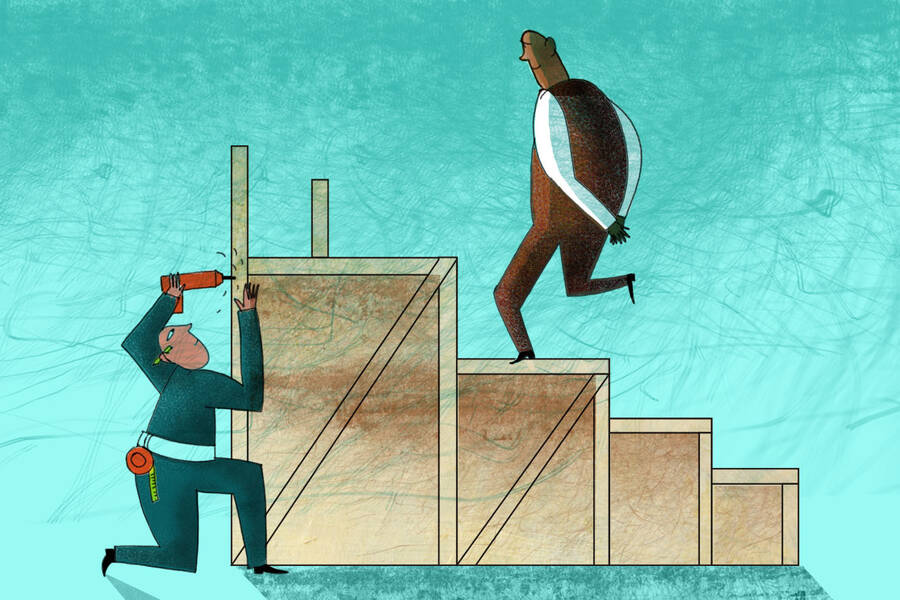Strategy May 1, 2025
How Higher Pay Incentives Can Backfire
While increasing bonuses and commission rates might seem like a good idea, doing so can inadvertently harm the quality of an organization’s workforce.

Yevgenia Nayberg
In the mid-1990s, Safelite, a windshield repair company, made a bold move. It replaced hourly wages with performance-based pay, offering employees the chance to earn more money the more windshields they installed. The results were striking.
Within a year, productivity surged by approximately 44 percent.
“That’s a massive increase,” says George Georgiadis, an associate professor of strategy at the Kellogg School of Management and an expert on performance-based incentives.
The reason for this productivity bump was nuanced. About half of the increase came from existing workers putting in more effort. The other half was due to a shift in the type of employees Safelite attracted. “The least productive employees left, and the new hires who replaced them were significantly more skilled and productive,” Georgiadis explains.
Safelite’s success story quickly became a textbook example in economics, illustrating how performance-based pay could boost productivity by both motivating current workers and attracting better talent.
Inspired by this example, many companies came to believe that continually increasing incentives—such as bonuses, commissions, or stock options—would naturally attract the best talent and drive productivity even higher. Indeed, many growth-focused companies, including tech giants like Google and Netflix, have adopted increasingly generous incentive structures, hoping to attract and retain top talent and keep profits climbing.
Yet despite its widespread popularity, this approach has a critical blind spot. It assumes that steepening incentives always leads to better employee selection—that it will attract more high-skilled and productive workers. But research by Georgiadis and his colleague Henrique Castro-Pires of the University of Miami challenges this assumption.
Their findings suggest that steeper incentives do not automatically guarantee better hires and, in some cases, can backfire.
The hidden downsides of steeper incentives
To that end, Castro-Pires and Georgiadis developed a mathematical model to explore how prospective employees respond to changes to incentive pay structures.
Their model considers the following scenario.
An employer, such as the manager at an organization, posts a job that offers performance-based pay.
Potential applicants—who vary in skill level—decide whether to apply based on how compelling the pay structure is compared with their other job opportunities. Each applicant undergoes a screening test that high-skilled applicants have a higher likelihood of passing than low-skilled applicants.The employer then chooses whom to hire among the applicants who pass the test, and each hired worker decides how hard to work.
“Steepening incentives is not a panacea for worker selection.”
—
George Georgiadis
Common wisdom suggests that increasing incentives would naturally attract more high-skilled applicants. But the researchers found that higher incentives tend to attract both more high-skilled and more low-skilled applicants.
In fact, depending on the job market, steeper incentives can disproportionately attract low-skilled workers. High-skilled workers often have more and better job opportunities than low-skilled workers, making them relatively scarce in the applicant pool. As a result, increasing incentives can inadvertently increase the proportion of low-skilled applicants, ultimately harming the quality of the employer’s workforce.
“Steepening incentives is not a panacea for worker selection,” Georgiadis says. “In some situations, it can actually hurt selection. Companies, therefore, need to actively think about how to structure incentives to improve their applicant pool.”
An example in sales
Take, for example, employees at a typical department store. Since their pay is commission-based, sales associates at the store might be incentivized to sell more if their manager bumps their commission rate up from, say, 5 percent to 7 percent.
At first glance, the higher commission rate seems like a shoo-in to attract better talent. After all, skilled salespeople can generate more sales, so they’d benefit most from higher commissions.
But the reality is more nuanced.
When the commission rate goes up, the job becomes more attractive not only to high-skilled associates but also to low-skilled ones. So even though high-skilled applicants can benefit more from the higher commission, there may be a greater number of low-skilled applicants who are drawn to the job’s greater earnings potential. And if the pool of potential low-skilled applicants expands more rapidly than that of high-skilled applicants—something that can easily happen depending on the job market for sales associates—then raising commissions might actually lead to hiring proportionally more low-skilled associates, harming the store’s overall workforce quality.
Because of this, “you have to systematically consider how incentives might unintentionally attract lower-skilled applicants, rather than assuming that stronger incentives automatically improve workforce quality,” says Georgiadis.
Practical steps for employers
While the researchers’ model doesn’t provide a one-size-fits-all solution, it does offer practical guidance for companies looking to optimize their incentive pay structures.
Georgiadis suggests that employers should design incentives that specifically appeal to high-skilled employees more than they do to low-skilled employees.
“If you simply increase pay across the board, everyone benefits and more people apply from both pools,” Georgiadis says. “But if you restructure incentives so that high-skilled employees are better off while low-skilled employees are not, then you improve selection by attracting more of the former.”
Of course, achieving this balance is easier said than done. Employers rarely have complete information about applicants’ alternative job options, their precise abilities, or their preferences.
To address this, Castro-Pires and Georgiadis propose a straightforward method companies can use to at least gauge whether the changes they make to their incentives are improving their workforce selection.
Employers would need to track two simple metrics before and after making an adjustment to their incentive structure: the total number of applicants and the number of applicants rejected during screening. If the total number of applicants increases more than the number of applicants who fail the screening test (in percentage terms), this indicates improved selection—that is, more high-skilled applicants are passing the screening process.
What’s more, the researchers developed a two-part test that can help employers pinpoint the optimal incentive structure.
First, the employer needs to make a small adjustment to their incentive-pay structure before hiring employees and observe how it affects the total number of applicants, as well as the number of applicants who fail the screening test. This experiment allows one to infer all of the incentive adjustments that improve worker selection.
Then, after hiring employees, the employer needs to make a second adjustment to the incentives and track how employee productivity responds to this change. Combining data from these two experiments provides just enough information for employers to identify the optimal incentive scheme for their situation.
“In principle, there are infinitely many scenarios to consider,” Georgiadis says. “But a key result shows that, under certain assumptions, data from these two simple tests is enough to guide employers toward the best incentive structure.”
Abraham Kim is the senior research editor of Kellogg Insight.
Castro-Pires, Henrique, and George Georgiadis. 2025. “Incentives and Selection.” Working paper.



